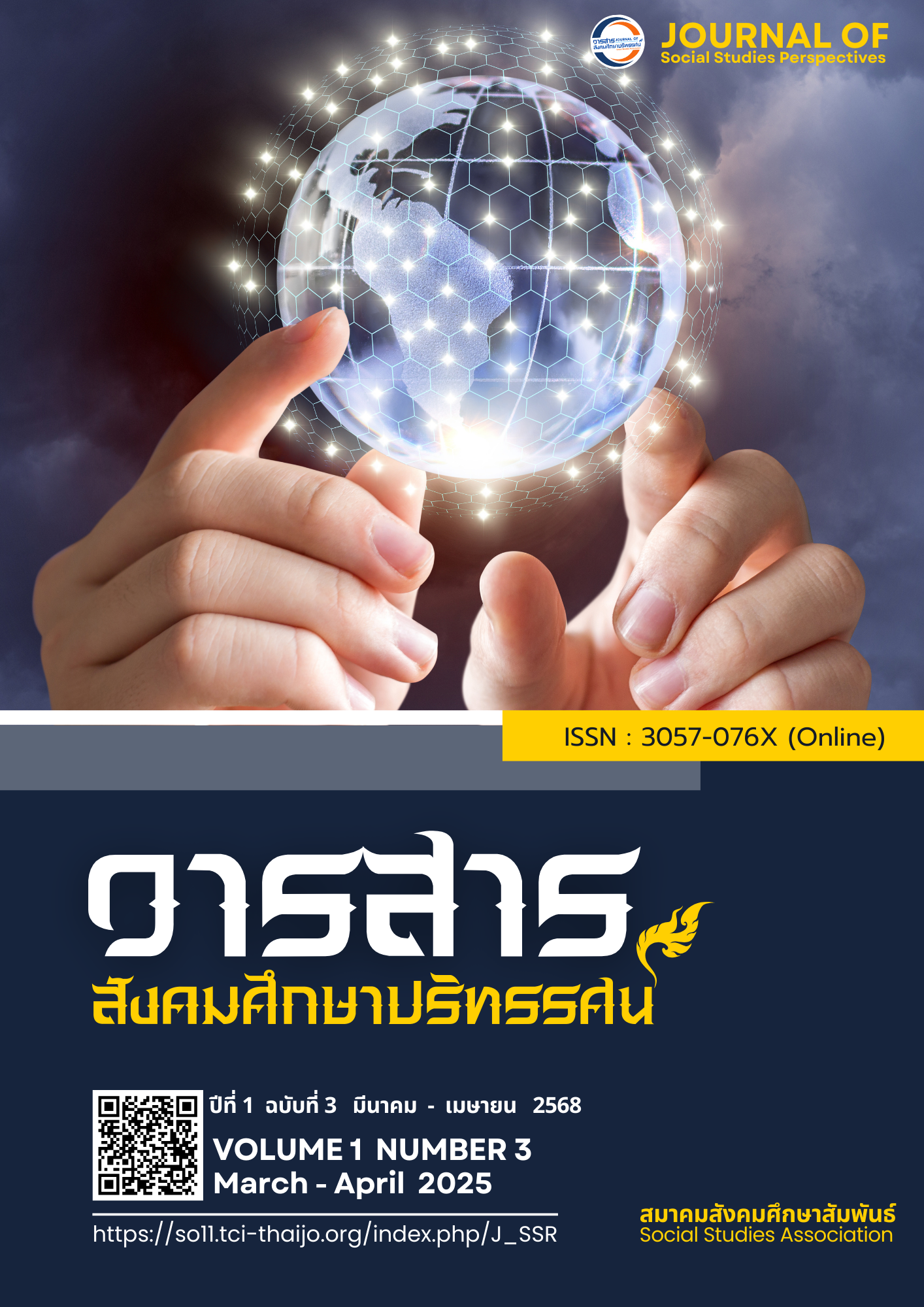ความสัมพันธ์ระหว่างสุขภาพจิตกับการผัดวันประกันพรุ่งของนักศึกษามหาวิทยาลัย
DOI:
https://doi.org/10.64186/jsp1411คำสำคัญ:
สุขภาพจิต, การผัดวันประกันพรุ่ง, นักศึกษามหาวิทยาลัยบทคัดย่อ
การวิจัยครั้งนี้มีวัตถุประสงค์ 1) ศึกษาสุขภาพจิตและการผัดวันประกันพรุ่งของนักศึกษามหาวิทยาลัย 2)เปรียบเทียบการผัดวันประกันพรุ่งตามตัวแปรเพศของนักศึกษามหาวิทยาลัย 3) ศึกษาความสัมพันธ์ระหว่างเกรดเฉลี่ยสะสมกับการผัดวันประกันพรุ่งของนักศึกษามหาวิทยาลัย และ 4) ศึกษาความสัมพันธ์ระหว่างสุขภาพจิตกับการผัดวันประกันพรุ่งของนักศึกษามหาวิทยาลัย กลุ่มตัวอย่างนักศึกษามหาวิทยาลัย ชั้นปีที่ 1-4 จำนวน 160 คน เครื่องมือที่ใช้ในการวิจัย ได้แก่ แบบสอบถามข้อมูลทั่วไป แบบประเมินภาวะซึมเศร้า วิตกกังวล และความเครียด (DASS-21) และแบบสอบถามการผัดวันประกันพรุ่ง สถิติที่ใช้ประกอบด้วย 1) สถิติเชิงพรรณนา ได้แก่ ความถี่ ร้อยละ ค่าเฉลี่ย ส่วนเบี่ยงเบนมาตรฐาน และ 2) สถิติเชิงอนุมานใช้วิเคราะห์สมมติฐาน ได้แก่ t-test ค่าสัมประสิทธิ์สหสัมพันธ์สเปียร์แมนและเพียร์สัน ผลวิจัยพบว่า 1) นักศึกษามหาวิทยาลัยมีการผัดวันประกันพรุ่งอยู่ในระดับปานกลาง (=2.50, S.D.=.62) นักศึกษามหาวิทยาลัยแทบจะไม่มีภาวะซึมเศร้า (ร้อยละ 50.6) มีภาวะวิตกกังวลระดับเล็กน้อย (ร้อยละ 26.3) แทบจะไม่มีความเครียด (ร้อยละ 52.5) 2) นักศึกษามหาวิทยาลัยเพศชายและเพศหญิงมีการผัดวันประกันพรุ่งไม่แตกต่างกัน 3) เกรดเฉลี่ยสะสมมีความสัมพันธ์ทางลบในระดับต่ำกับการผัดวันประกันพรุ่ง (r=-.270, p<.05) อย่างมีนัยสำคัญทางสถิติที่ระดับ .05 4) นักศึกษามหาวิทยาลัยที่มีภาวะซึมเศร้ามีความสัมพันธ์ทางบวกในระดับปานกลางกับการผัดวันประกันพรุ่ง (r=.568, p<.05) อย่างมีนัยสำคัญทางสถิติที่ระดับ .05 ภาวะวิตกกังวลมีความสัมพันธ์ทางบวกในระดับต่ำกับการผัดวันประกันพรุ่ง (r=.394, p<.05) อย่างมีนัยสำคัญทางสถิติที่ระดับ .05 และความเครียดมีความสัมพันธ์ทางบวกในระดับปานกลางกับการผัดวันประกันพรุ่ง (r=.521, p<.05) อย่างมีนัยสำคัญทางสถิติที่ระดับ .05
เอกสารอ้างอิง
Bolbolian, M., Asgari, S., Sefidi, F., & Zadeh, A. S. (2021). The relationship between test anxiety and academic procrastination among dental students. Journal of Education and Health Promotion, 10, 67.
Bytamar, J. M., Saed, O., & Khakpoor, S. (2020). Emotion regulation difficulties and academic procrastination. Frontiers in Psychology, 11, 524588.
Chuthong, R., Wiwatthanaworaset, P., Buatong, N., Nuthong, Y., Yusuk, C., Rungruang, N., Mad-Awa, N., Saelim, P., Chaitaveesap, P., Chicharoen, P., Jantsuwun, R., & Srayuthpitak, O. (2019). Mental health status and the role of families in undergraduate students at a university in southern Thailand. Journal of the Psychiatric Association of Thailand, 64(4), 337–350.
Cjuno, J., Palomino-Ccasa, J., Silva-Fernandez, R. G., Soncco-Aquino, M., Lumba-Bautista, O., & Hernández, R. M. (2023). Academic procrastination, depressive symptoms and suicidal ideation in university students: A look during the pandemic. Iranian Journal of Psychiatry, 18(1). 11-17.
Cohen, J. (1977). Statistical power analysis for the behavioral sciences (2nd ed.). Academic Press.
Custer, N. (2018). Test anxiety and academic procrastination among prelicensure nursing students. Nurse Educator, 39(3), 162-163.
Desai, M., Pandit, U., Nerurkar, A., Verma, C., & Gandhi, S. (2021). Test anxiety and procrastination in physiotherapy students. Journal of Education and Health Promotion, 10, 132.
Ferrari, J. R., Johnson, J. L., & McCown, W. G. (1995). Procrastination and task avoidance: Theory, research, and treatment. Plenum Press.
Gohain, R. R., & Gogoi, S. (2020). Academic procrastination among university students: A gender-based study. Asian Journal of Home Science, 15(2), 399-403.
Hayat, A. A., Kojuri, J., & Mitra Amini, M. D. (2020). Academic procrastination of medical
students: The role of Internet addiction. Journal of Advances in Medical Education &
Professionalism, 8(2), 83-89.
Jiang F. (2024). The relationship of academic procrastination on non-English majors' English
classroom anxiety: A moderated mediation model. Frontiers in Psychology, 15,
Mushtaque, I., Awais-E-Yazdan, M., & Waqas, H. (2022). Technostress and medical students’
intention to use online learning during the COVID-19 pandemic in Pakistan: The
moderating effect of computer self-efficacy. Cogent. Education, 9(1).
Oei, T. P., Sawang, S., Goh, Y. W., & Mukhtar, F. (2013). Using the Depression Anxiety Stress
Scale 21 (DASS-21) across cultures. International Journal of Psychology, 48(6), 1018-
Office of Registration and Student Statistics, Prince of Songkla University, Pattani Campus.
(2024). Online registration and student statistics report for the year 2024.
Punyawong, V., Santithadakul, R., & Phavasuthipaisit, C. (2020). Prevalence of depression and
suicide risk in Thai adolescents: A survey in 13 health regions. Journal of Mental
Thailand, 28(2).
Phuprasom, N. (2021). The situation of student health in Thailand 2021. School-Age Children's Health Group, Health Promotion Division, Department of Health.
Ragusa, A., González-Bernal, J., Trigueros, R., Caggiano, V., Navarro, N., Minguez-Minguez, L., A., Obregón, A. I., & Fernandez-Ortega, C. (2023). Effects of academic self-regulation on procrastination, academic stress and anxiety, resilience and academic performance in a sample of Spanish secondary school students. Frontiers in Psychology, 14, 1073529.
Sanitluea, N., Satphet, W., & Napha-arak, Y. (2019). Sample size calculation using G*Power program. Academic Journal Suvarnabhumi Institute of Technology, 41(1), 497–507 (in Thai).
Saplavska, J., & Jerkunkova, A. (2018). Academic procrastination and anxiety among students.
In Proceedings of the 17th International Scientific Conference Engineering for Rural
Development (pp. 1192–1197). Latvia University of Life Sciences and Technologies.
Siaputra, I. B. (2010). Temporal Motion Theory: Best Theory (yet) to Explain Procrastination.
Sonthung, M. (2019). The effects of group counseling based on the cognitive-behavioral
approach on academic procrastination in undergraduate students (Master's thesis).
Department of Counseling Psychology, Faculty of Social Sciences, Chiang Mai University.
a detrimental habit. Frontiers in Psychology, 13.
Svartdal, F., Dahl, T. I., Gamst-Klaussen, T., Koppenborg, M., & Klingsieck, K. B. (2020). How study environments foster academic procrastination: Overview and recommendations. Frontiers in Psychology, 11, 540910.
Taveerat, P. (1997). Methods of research in behavioral and social sciences (7th ed.). Bangkok: Educational Testing and Psychological Service, Srinakharinwirot University.
UNICEF, & Department of Mental Health. (2021). Covid-19 pandemic continues to drive poor mental health among children and young people. https//www.unicef.org/thailand/press-releases /covid-19-pandemic-continues-drive-poormental-health-among-children-and-young-people
ดาวน์โหลด
เผยแพร่แล้ว
รูปแบบการอ้างอิง
สัญญาอนุญาต
ลิขสิทธิ์ (c) 2025 วารสารสังคมศึกษาปริทรรศน์

อนุญาตภายใต้เงื่อนไข Creative Commons Attribution-NonCommercial-NoDerivatives 4.0 International License.
บทความนี้ได้รับการเผยแพร่ภายใต้สัญญาอนุญาต Creative Commons Attribution-NonCommercial-NoDerivatives 4.0 International (CC BY-NC-ND 4.0) ซึ่งอนุญาตให้ผู้อื่นสามารถแชร์บทความได้โดยให้เครดิตผู้เขียนและห้ามนำไปใช้เพื่อการค้าหรือดัดแปลง หากต้องการใช้งานซ้ำในลักษณะอื่น ๆ หรือการเผยแพร่ซ้ำ จำเป็นต้องได้รับอนุญาตจากวารสาร










